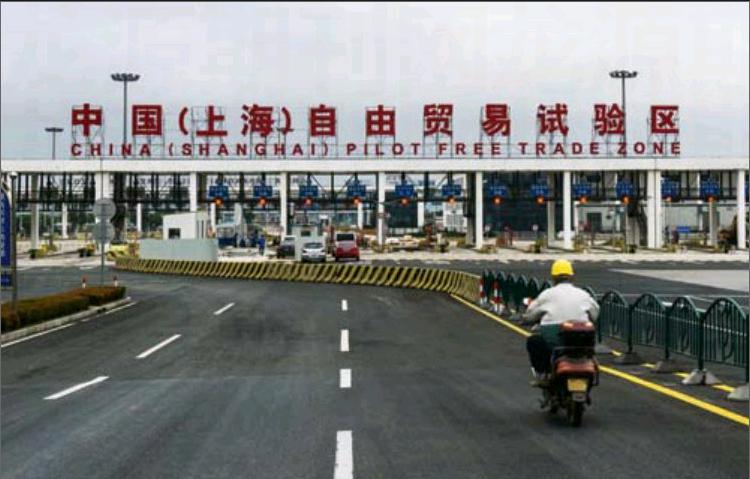Five Questions for Chinese Free Trade Zones
by+Gong+Haiying


By the end of November 2014, 22,000 enterprises were found in SFTZ, among which 14,000 were established after SFTZs founding, surpassing all numbers of the previous 23 years. A total of 2,114 foreign-funded enterprises were newly established, a ten-fold increase on a year-on-year basis.
SFTZs overseas investment has been developing rapidly. About 160 overseas investment cases have been completed and Chinese companies have invested nearly US$3.8 billion in foreign lands.
Q: How many free trade zones (FTZ) can be found in China today? What are the features of recent applicants?
A: The Shanghai Pilot Free-Trade Zone was the first FTZ in China. On August 22, 2013, Chinas State Council approved the establishment of Shanghai FTZ(SFTZ). When it was established, the zone integrated existing bonded zones in Shanghai with Waigaoqiao Free Trade Zone at the core along with Yangshan Free Trade Port Area and Pudong Airport Comprehensive Free Trade Zone, becoming a new experimental field for Chinas economy. Reform measures on governmental functions, financial institutions, trade services, foreign investment, and taxation policy are carried out in this zone.
In December 2014, the area of SFTZ expanded to nearly 121 square kilometers from the previous 29 square kilometers. At the same time, China approved the establishment of three new FTZs in Tianjin, Guangdong and Fujian.
At present, applications for the third group of FTZs in China are being accepted. Liaoning, Shaanxi, Gansu, Henan, Guangxi, Shandong are applying for FTZ establishment.
Q: Why did China approve the establishment of three new FTZs in late 2014?
A: The establishment of FTZs in Guangdong, Fujian, and Tianjin is based on the Shanghai FTZs initial success. After more than a year of practice, SFTZ has tested nearly 30 innovation measures and reported results to the central government, including innovative initiatives on negative lists, crossborder investment and trade rules.
Although the new FTZs will adopt many measures that have proven successful in Shanghai, the concept is becoming more localized and diversified, which means starting in 2015, China is entering a new phase of FTZ reform and innovation. Based on their own characteristics, the second group of FTZs will cooperate with SFTZ but also utilize their unique strengths. For example, the Tianjin FTZ will place priority on shipping and related industries for its development, and can fully cooperate with Shanghai to form a powerful force in the future.

Q: What has SFTZ achieved since its establishment a year ago? Which experiences are most valuable for other parts of China?
A: At present, SFTZ has established an investment management system with a negative list as its core. Its trade system, aiming at trade facilitation, has been running smoothly. Its innovative financial institution, with aims of realizing capital account convertibility and opening the financial services industry, has been established. A supervision system, with transformation of government function as its guiding princi- ple, has taken shape. In terms of establishing a basic framework and mechanism which is consistent with international investment and trade rules, SFTZ has achieved important advancements.
Experiences with some institutions such as reform of the governmental administrative system can be promoted and publicized to the entire nation to enhance societys governance ability. However, in terms of some special institutions, such as finance and trade facilitation, for the time being, they can only be promoted and carried out in specially designated areas. Its worth mentioning that financial leasing companies are allowed to conduct commercial factoring business related to their primary businesses, and foreign enterprises are allowed to engage in the manufacturing and sales of entertainment and gaming consoles in SFTZ. Both mark firsts in China.
Q: What are the changes the four FTZs will bring to Chinas overall FTZ structure?
A: The three new FTZs are more cross-regional. For example, Guangdong FTZ incorporates Shenzhens Qianhai and Shekou districts, Zhuhais Hengqin District, and Guangzhous Nansha New District. Fujian FTZ incorporates areas in Fuzhou, Xiamen, and Pingtan, and Tianjin FTZ incorporates Tianjin Port, Tianjin Airport Zone, and Binhai New Area Central Business District.
The new FTZs employ their own opening-up policies. Compared to the more international SFTZ, the three new FTZs are more target-oriented. For example, Tianjin FTZ positions itself as the center of northern Chinas economic development. Aiming for Northeast Asia, it will seek a balanced and coordinated development among Beijing, Tianjin, and Hebei. Fujian FTZ aims at Taiwan, in hopes of realizing closer economic ties on both sides of the Taiwan Straits. Guangdong FTZ aims for Hong Kong and Macao, placing emphasis on economic integration in the Pearl River Delta, deepening joint development cooperation between Guangdong, Hong Kong, and Macao and bringing new economic growth points to these places.
Additionally, new FTZs will conduct deeper exploration based on SFTZs experience. For example, Guangdong FTZ will spare no efforts to open up and reform financial innovation, and may open fields of cross-border RMB business and land finance.
Q: What changes will Chinas FTZs bring to the general public?
A: For the general public, FTZs will bring big changes in realms of shopping, healthcare, education, tourism, and investment.
In terms of shopping, the cultivation of cross-border e-commerce services is important for FTZs. Standard retail commodities are available to consumers in FTZs, but they will also include commodities which havent yet entered the Chinese market in bonded trading and exhibition platforms in specially designated areas, while abiding by Chinas import and export tax policy. With more imports, Chinese consumers will find greater choices.
In terms of the service sector, foreign medical institutions and Sino-foreign for-profit educational institutions are allowed to be established in FTZs, which means that in the future, FTZs will facilitate foreign-funded medical services and education. Qualified joint venture travel agencies can also register in FTZs, providing tourism services to various destinations beyond Chinese mainland except Taiwan.
SFTZ will carry out pilot programs that allow individuals to open capital accounts, greatly expanding the Chinese peoples channels for overseas investment.

